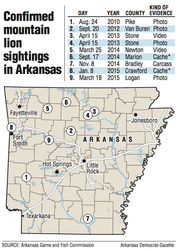Citing a DNA test conducted on a male mountain lion that was killed in November by a deer hunter in Bradley County, the Arkansas Game and Fish Commission announced Wednesday that the cat probably came from the Black Hills area of Wyoming and South Dakota and was the same mountain lion that was seen in Marion County in September.
Douglas Ramer, 62, of Bastrop, La., killed the mountain lion Nov. 8 while deer hunting on private property near Hermitage. He said he felt threatened when the mountain lion approached his stand and shot it in self-defense.
According to Arkansas Game and Fish Commission regulations, non-game wildlife except migratory birds and endangered species that present a reasonable threat to people or property may be shot during daylight hours or trapped without a depredation permit.
Game and Fish Commission biologists received the DNA results this week from Wildlife Genetics Laboratory in Missoula, Mont. The Bradley County mountain lion is a new individual to the lab's DNA database. The profile showed that its tissue sample matched the hair sample collected from mountain lion hair found on private land in southern Marion County. The distance between the two areas is about 180 miles.
Myron Means, the AGFC's large carnivore biologist, said the mountain lion traveled from Marion County to Bradley County in a period of about six weeks before it was killed.
The lab investigated the potential origin for the mountain lion using the lab's database that includes mountain lion samples from populations in South Dakota, North Dakota, Nebraska, Montana, Idaho, Wyoming, Colorado, New Mexico, Arizona, Texas, Oregon and Florida.
In this case, the probability of two mountain lions with the same genetic profile is one in 182 trillion, according to a news release issued Wednesday by the AGFC.
Means said it is unknown if the mountain lion is part of a breeding population in Arkansas, but he said he believes it was a subordinate male that adult males had driven from its native habitat. Adult male mountain lions do not tolerate subordinate males in their territories, Means said.
"It's natural dispersal," Means said. "Populations may be at or near carrying capacity for that area. Whenever new animals are born into that population, especially if there are more being born into it than taken out of it, the population will expand."
Biological carrying capacity is the ability of a habitat to support a given number of animals. When mountain lions reach or exceed their habitat's carrying capacity, subordinate males migrate into new territories looking for female mountain lions.
Conversely, adult mountain lions do tolerate subordinate females.
"That's why we see cats moving out of areas in the upper Midwest and moving across marginal or sub-marginal or even suitable habitats," Means said. "They're sent packing. Once they become adult cats, if there aren't females in that area, they're going to keep moving to find opportunities to procreate."
If a female mountain lion is in an area, the male will find it, Means said.
"If a female does show up, you will have a breeding population," Means said.
Means said he does not believe there is a breeding population of mountain lions in Arkansas, Missouri or eastern Oklahoma because only male mountain lions have been documented in those states. There is a breeding population in the Oklahoma Panhandle, Means said, but there is no natural corridor for those cats to migrate across Oklahoma into Arkansas.
The South Dakota mountain lions migrate south down the Missouri River corridor. From there they can filter easily into the northern Ozarks of Missouri and into the southern Ozarks of Arkansas.
"That's just a natural dispersal route," Means said.
As evidenced by the Bradley County cat, mountain lions have large ranges and cover a lot of territory quickly. Consequently, multiple mountain lion sightings in a general area could be a single cat.
"Sometimes it seems like, golly, we're seeing these cats everywhere, but that might be misleading to the general public," Means said. "What I have been told by cat experts is that you will typically have a cluster of sightings that might take place over two to 18 months in a three- to five-county area. Then all of a sudden they just stop."
Nine sightings of mountain lions in Arkansas have been confirmed in the past five years, including a cluster in Marion and Stone counties over a two-year period that suddenly stopped not long before the Bradley County cat was killed, Means said.
Before November, the last mountain lion killed in Arkansas was in 1975 in Logan County.
Sports on 06/11/2015
